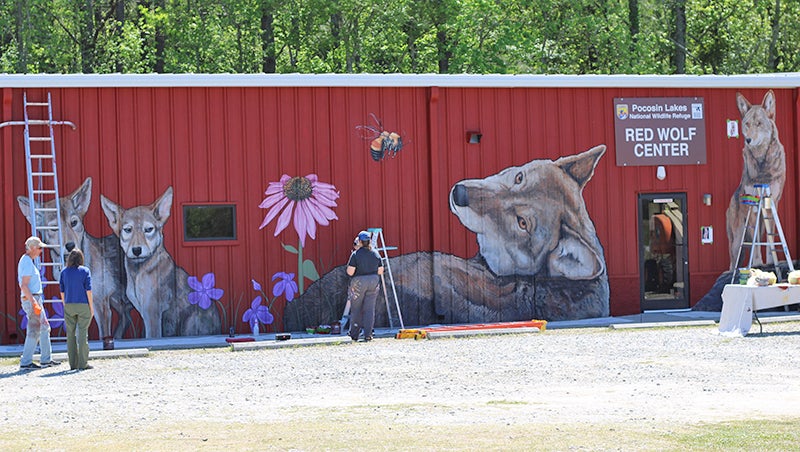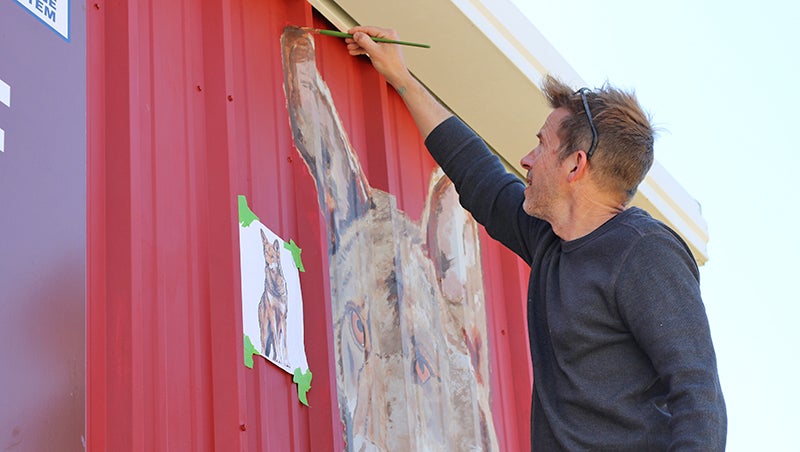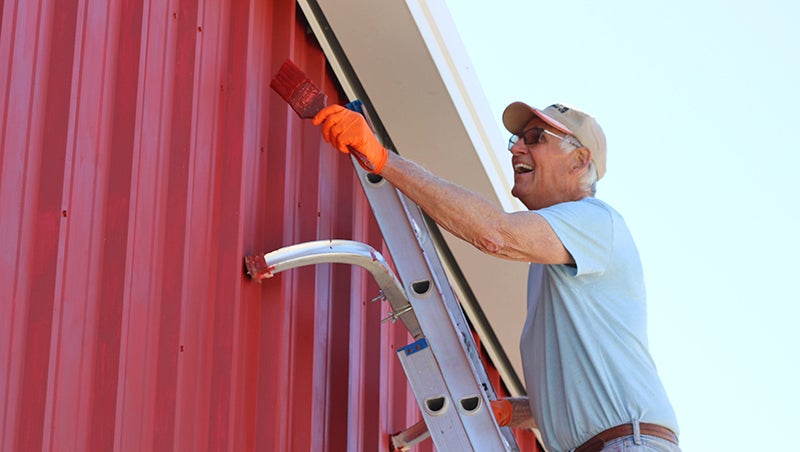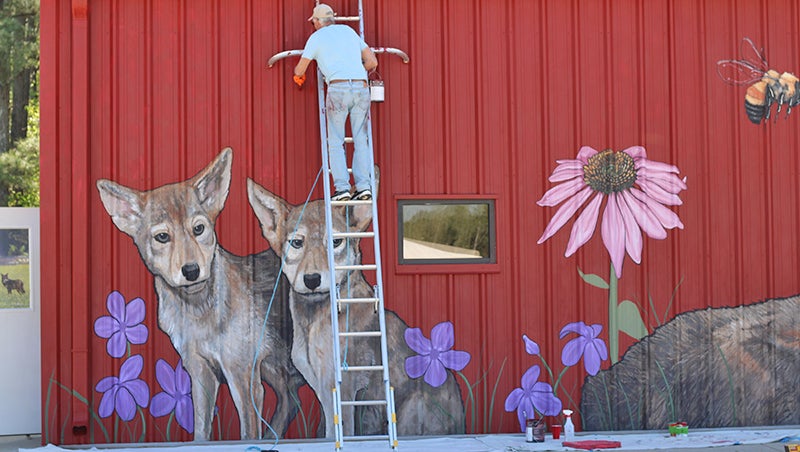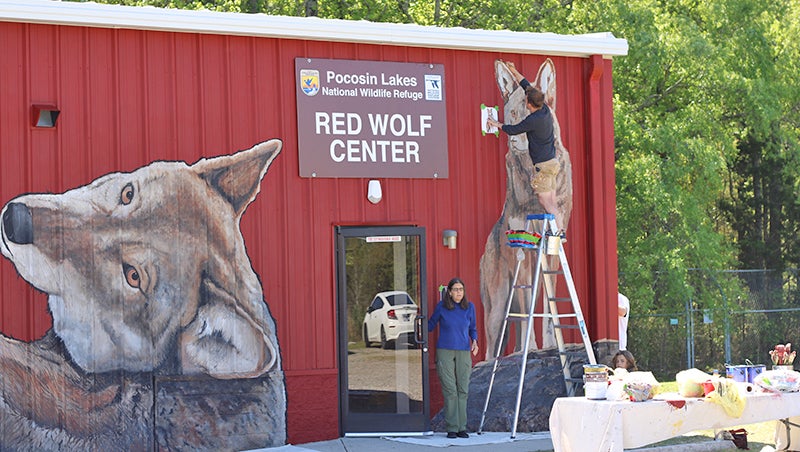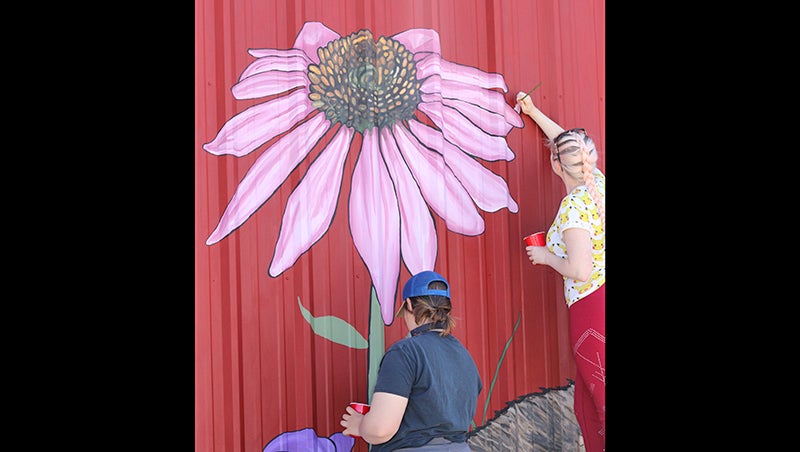Red Wolf Center building transformed: Renowned muralist Matt Willey brings awareness to endangered red wolf population through art
Published 1:19 pm Tuesday, April 25, 2023
|
Getting your Trinity Audio player ready...
|
Over the course of two weeks, the Red Wolf Center on Pocosin Lakes National Wildlife Refuge in Columbia has been transformed from a nondescript beige building to an eye-catching work of art.
Muralist Matt Willey, founder of The Good of the Hive, connected with Champions for Wildlife founders Dale and Loti Weiler to paint three sides of the U.S. Fish & Wildlife Service Red Wolf Center, located one mile south of Columbia on Highway 94, with a snapshot of the importance that all species – big and small – play an important role in creating a healthy, thriving environment. The project began at the beginning of April.
The mural features four red wolves, an apex predator – meaning the top of the animal food chain – surrounded by one of the smallest, though no less critical insects – bees – and the flowers they pollinate.
The Red Wolf Center was constructed in 2007, and in 2012, a fenced enclosure was added to house two red wolves.
Though there are several hundred red wolves in protected centers throughout the country, there are less than 20 in the wild in the world today, and they are all in eastern North Carolina.
At the center, there are red wolf talks on Wednesdays at 10 a.m. and 3 p.m., and on Fridays at 10 a.m., 1 p.m. and 3 p.m., where N.C. Wildlife Federation Red Wolf education and outreach coordinator Katerina Ramos teaches people about the history, biology and management of the red wolves.
“The Red Wolf Center is the heart of the red wolf recovery program,” said Loti Weiler, who works with her husband, a wildlife sculptor, to bring education programs to school children throughout the state.
“They’re amazing animals. They mate for life, they’re fabulous parents. You know, people are afraid of wolves, like ‘they’re going to eat my grandmother and my babies.’ We always ask kids [during our educational programs], ‘How many how many people have ever been hurt by red wolves?’ and the answer is zero. There’s never been an attack on a person. They’re really way more afraid of us than we are of them,” Weiler said.
Their programs include an art component, whether its sculpting a red wolf from clay or creating a collage of birds.
“We’re trying to educate people, too, because we believe the more you learn, the more you love, and you can’t protect any animal you don’t know about and love,” she added.
The Weilers met Willey at a party – a party to celebrate a unique species of fireflies, to be specific – and they connected over their shared desire to bring awareness to endangered and protected species.
Willey is well known in the art world for his larger than life depiction of bees. He’s about a fifth of the way to his goal of painting 50,000 bees. He said his curiosity was piqued in 2008 when he encountered a bee on the floor of his studio and connected with her.
Willey sprays water on his red Solo cups full of paint to keep them from drying out before climbing down from his ladder and sharing the story of how he came to paint bees all over the world.
“It was like, this was not at all what I thought it was – it was a paradigm shift. It turned into really an exploration through curiosity artistically,” he said
“When I went closer to that bee and got curious, something opened in me and that is what these murals are about – painting the red wolves bigger than they would normally be or,” he said as he stretched his arms out wide, “the bees all become this big on walls so that that experience I had by going closer mimics that or echoes that. In murals, people can have that experience.”
He has long since expanded his artwork to include all pollinators, because of the important role they play in maintaining a healthy habitat for all ecosystems.
This project is the first time in his career he has painted with a team of people to create a mural. Because the deadline on the project was only two weeks, Willey worked with Dale Weiler, who has sculpted red wolves using alabaster and several local artist students from the Pocosin Arts School of Fine Craft.
The building is made from corrugated metal with thick vertical ridges every 12 inches or so. This posed a significant challenge for Willey, as well as having to arrange the mural around the sign, a door and a window.
He began the mural by projecting the images onto the building and sketched out the basic design, then used small photos taped up near his workspace to make the animals look realistic.
The project took about two weeks to complete, but will be appreciated for years to come.
“This is more than just a mural,” Dale Weiler said. “It’s about getting the community behind the red wolves. This is a magical place – there’s wildlife here that is just extraordinary including the rarest wild animal in the U.S. today. So [this mural] is just about getting people involved, getting them engaged, and getting them passionate.”
For more information about the Red Wolf Center, visit fws.gov/refuge/pocosin-lakes/visit-us/locations/red-wolf-center.
SUBSCRIBE TO THE COASTLAND TIMES TODAY!


